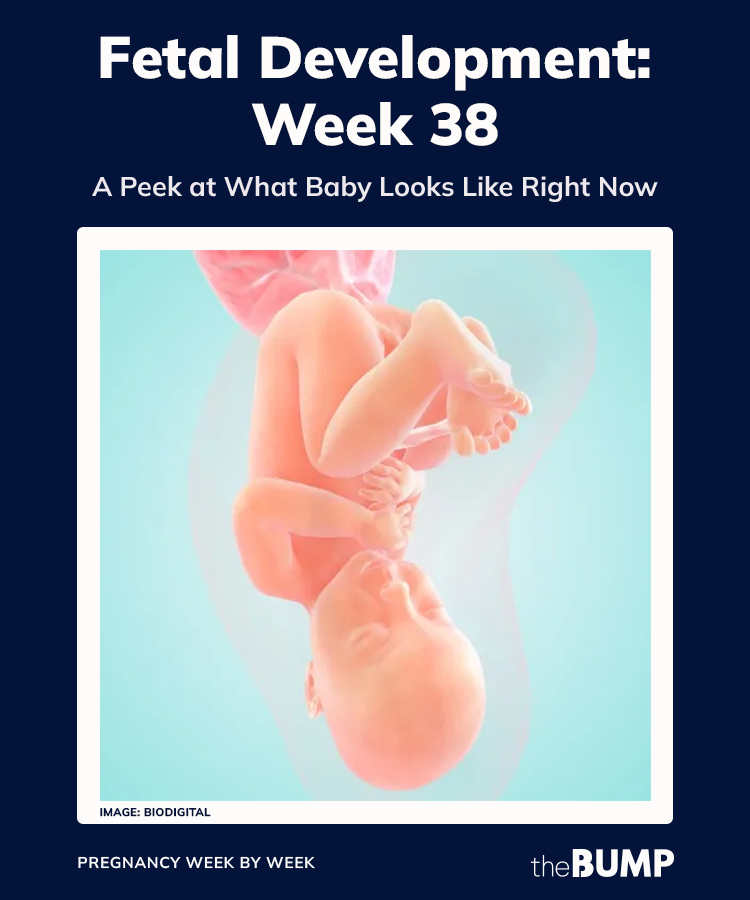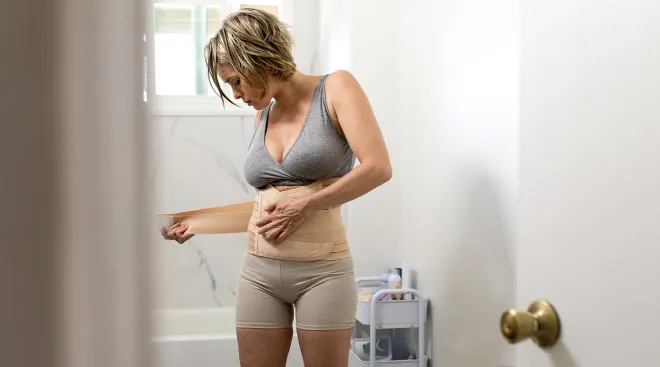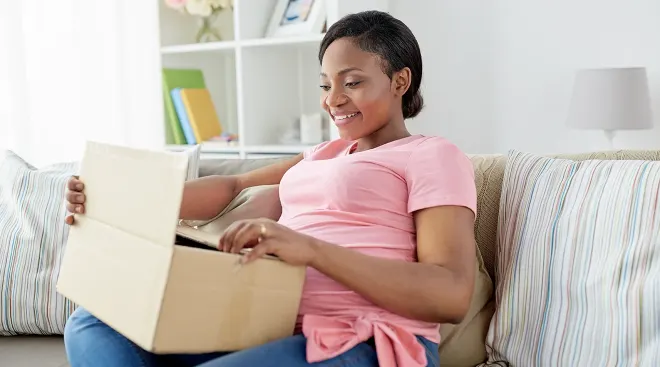- Feeling the burn? Baby may be wreaking havoc on your digestive system and causing heartburn and reflux. Their quarters are nice and cramped, so they’re putting pressure on all your organs. Maybe avoid spicy food—despite the old wive’s tale that it may kick-start labor.
- Diarrhea is also common at this late stage of the game as hormones continue to loosen you up for the big delivery event!
- At this week’s appointment, your ob-gyn or midwife will give you an exam to check if you’re effaced and dilated. In other words, they’re feeling around to see if your cervix has thinned and opened at all yet.
If you feel a lightning bolt-like sensation running up and down your legs (and in your vagina!), don’t freak out. At 38 weeks pregnant, baby is probably sitting pretty low in your pelvis, which means they’re bumping into all kinds of nerves down there—including some super-sensitive ones you might not know you had. The big event could happen any day now—or it might not be for a few weeks. Until then, try to chill.
Inside your 38 weeks pregnant belly, baby may have some hair already. Baby is slowly shedding that white goo on the skin (remember, that stuff called vernix caseosa?) but you might see some of it at birth.
How big is baby at 38 weeks pregnant?
At 38 weeks pregnant, baby is as big as a winter melon. Baby is about 19.6 inches long give or take, and their head is about the same circumference as their abdomen. Average baby weight at 38 weeks is 6.8 pounds. Sounds a lot like a birth weight, huh?
38 weeks pregnant is how many months?
At 38 weeks pregnant you’re nine months pregnant. You’re heading down the home stretch of pregnancy.
38 week ultrasound
You’re seeing the OB weekly now, so you’ll have an appointment this week. At these weekly appointments, your doctor will check that baby is in a head-down position and to see if the head has moved down into the pelvis. Also, get ready for a pelvic exam, where your cervix will be checked for dilation (opening) and effacement (thinning)—both signs your body is readying for labor. Unfortunately, there’s no “normal” when it comes to predicting labor based on dilation or effacement; if you’ve started, it could be hours or weeks before labor starts. But even if you’re not dilated at all, you could still go into labor tomorrow. Ah, the unpredictability of childbirth!
If your doctor wants a more in-depth check on baby, they may order a 38 weeks pregnant ultrasound to see the size of the baby. They may also order a biophysical profile, during which baby’s breathing, movement, muscle tone, heart rate and amniotic fluid will be scored. In some cases, the result of the biophysical profile could make your doctor decide to deliver baby earlier than your due date.
Common 38 weeks pregnant symptoms have everything to do with being really, really pregnant. You’re big; baby is almost ready to arrive and your body is getting ready for D-day (that’s delivery day). Here’s how your body is affected:
Braxton Hicks contractions
At 38 weeks pregnant, contractions are to be expected. You may have been having these for weeks now, or you may be just starting to notice what seems like 38 weeks pregnant cramps or tightening of your belly. If your contractions aren’t painful, and go away when you switch positions, they’re still Braxton Hicks (aka “practice” contractions).
Trouble sleeping
Maybe you’re feeling anxious, or maybe it’s just all the aches and pains. But for someone who’s so tired, man it’s hard to get a good night’s rest!
Increased vaginal discharge
You may begin to notice globs of a thick, mucus-like substance in your discharge this week. This yucky stuff is called the mucus plug, and its presence is totally normal. It gets released as your cervix dilates in preparation for labor. Take heart; every bit of the mucus plug brings you that much closer to going into labor!
Itchy belly
Your 38 weeks pregnant belly is stretched practically as far as it can go, so it makes sense that it’s more sensitive. What’s not normal is a rash, so let your OB know if you get one.
Swollen feet and ankles
You’re 38 weeks pregnant, so basically you have the excuse to sit back and put up your feet as much as humanly possible to reduce the swelling.
Is 38 weeks pregnant full term? You’re so close! At 38 weeks pregnant, you’re what’s called “early term.” It’s almost an in-between stage—you’ve passed preterm (which is before 37 weeks) but you’re not yet at full term (which starts at 39 weeks). At this point, you’re counting down the days!
At 38 weeks pregnant, signs of labor may begin. Some early signs you’ll go into labor soon include:
Mucus plug and/or bloody show
You might have a discharge that’s thick like mucus (the mucus plug) and could have a slightly bloody tinge (the bloody show). This is a sign your cervix is starting to dilate in preparation for birth.
Diarrhea
At 38 weeks pregnant, diarrhea might not be because of that spicy food you ate—it could be a sign that labor hormones are present in your body. It may be “go time” very soon.
Nausea
Same goes for 38 weeks pregnant nausea. This isn’t a measurable sign of labor, but some women swear they felt queasy just before labor started.
Contractions
At 38 weeks pregnant, contractions may be a normal part of your day—or maybe you haven’t noticed any yet. But know that if your 38 weeks pregnant belly starts tightening at regular intervals and doesn’t stop, then you’re likely in the early stages of labor. Painful contractions or ones that are closer than five minutes apart and last more than two hours are probably a sign that you’re in labor and ready to go to the hospital!
Back pain
You may have had a sore back for weeks now, but at 38 weeks pregnant, back pain that’s intense or sudden could actually be back labor, so let your doctor know if you’re experiencing this 38 weeks pregnant symptom.
Water breaking
If you feel a trickle of water, it means the amniotic sac has ruptured and the fluid is leaking out. Labor usually starts pretty soon after a woman’s water breaks, so let your OB know if you get this 38 weeks pregnant symptom.
How dilated should I be at 38 weeks?
It’s different for every mom-to-be. Some women may not be dilated yet, while others may be a centimeter or two. Your OB will check on this during your weekly appointments. If you’re 4 centimeters dilated, get ready—you’re in active labor!
Can I deliver at 38 weeks?
Yes! Babies tend to come on their own timeline, and sometimes that’s a couple of weeks early. But remember that at 38 weeks pregnant, you’re still technically “early term,” so don’t be in a rush to try to induce labor on your own. Baby usually needs a little more time on the inside. That said, at 38 weeks pregnant, inducing labor may be medically necessary if you have a complication such as preeclampsia or gestational diabetes, a uterine infection or a placental problem. If you’re 38 weeks pregnant with twins, or if you’re experiencing bleeding at 38 weeks pregnant, your doctor might say, “it’s time!” This can send any mom-to-be who thought she had two more weeks into a panic, but know that everything will be okay. We can never really be 100 percent ready (well, maybe you’re one of those women who makes it to week 42), and you and baby are in good hands while under the care of your OB and the pediatrician.
Birth is right around the corner now! Even the coolest cucumbers might be feeling some anxiety creep in. Fear, when broken down, is often associated with a sense of unknown and a lack of education and awareness about something. Try to work on easing these feelings through education, positive birth stories and discussions with your provider. There’s still time to get the sense of confidence and control you deserve!
It’s almost go time. Here’s what you can do right now to show yourself some TLC.
Show your belly some love
Your itchy belly may be uncomfortable right now (and there’s also the matter of being 38 weeks pregnant!), so do what you can to feel better. Rubbing on a heavy-duty moisturizer, like pure shea butter, can help with dry, overstretched skin, and so does staying hydrated with lots of water.
Go for a walk in the park
Get that blood flowing to reduce swelling while enjoying fresh air and beautiful scenery. Pretty soon, you’ll be walking a stroller in the park!
Stop and smell the lavender
This scent is known for its calming, relaxing qualities, so it’s a great natural sleep aid. Scent your bedroom with lavender essential oil in a diffuser or diluted with water in a room spray.
Find a reliable timer
Bookmark The Bump contraction timer! To figure out if you’ve got Braxton Hicks contractions or the real deal, you’ll need to know when each contraction starts and how long they last. Braxton Hicks contractions are generally painless contractions that stop. If your contractions continue and are painful, it’s time to call your OB!
Frequently Asked Questions
Is it okay if I'm not at all effaced or dilated yet?
Effacement (how thin your cervix is) and dilation (how open your cervix is) are two measures providers use to determine how close you are to going into labor. At 38 weeks, your cervix might be getting thinner and more open—or it might not!
For first-time pregnancies in particular, the cervix may not efface or dilate until the very end of your pregnancy. Unless there’s a reason why you need to deliver at 38 weeks, most providers won’t be concerned about a cervix that isn’t ready for labor at this point. If you do suddenly need to deliver—or if you’re still not effaced or dilated even at 41 weeks—your provider will talk to you about cervical ripening to induce labor.
Why might my doctor recommend a biophysical profile?
A biophysical profile is a test that may be done in the third trimester to check on Baby’s health. There are two components to a biophysical profile: a nonstress test and an ultrasound. It’s not standard—it’s typically done when you have certain risk factors of pregnancy, or when there’s decreased fetal movement. Common risk factors associated with biophysical profiles include hypertension, gestational diabetes, obesity, multiples and other chronic health conditions. It may also be done if you don’t go into labor by 42 weeks gestation.
Do I need to be induced if I'm having twins?
It’s not a requirement, but many women do end up scheduling an induction to deliver twins so their healthcare team can be better prepared to handle a multiples delivery. If you’re having a healthy pregnancy, your provider may allow you to go into labor naturally and attempt a vaginal delivery for both babies, but if they have any concerns about delivery (for example, if one or both babies are breech, or they share a placenta and amniotic sac), then you may be scheduled for an induction, if not a C-section, so your babies can be born safely.
What does the bloody show indicate about labor progression?
The bloody show is a mucousy, blood-tinged discharge that happens when early labor contractions cause the cervix to dilate and the blood vessels in the cervix rupture and bleed.
Although the bloody show can mean that labor is imminent or starting, it doesn’t always mean that: some women have their bloody show a few weeks before labor begins. Either way, though, the bloody show does mean that your body is preparing for the early stages of labor.
Does lightning crotch mean labor is coming?
Lightning crotch isn’t a medical term, but any woman who has been pregnant probably knows the feeling! This sudden burning or stabbing pain in your pelvis or vagina is common during the third trimester, as baby begins to put more pressure on your cervix and the nerves become inflamed, but it’s not necessarily a sign of labor. It can happen before labor, but it can also happen anytime between 28 and 40 weeks.
I made sure to have a mantra for labor: If baby can do it, I can do it. It gave me the confidence I needed to enter into birth. My body created this baby, and my body knows how to birth this baby.
Please note: The Bump and the materials and information it contains are not intended to, and do not constitute, medical or other health advice or diagnosis and should not be used as such. You should always consult with a qualified physician or health professional about your specific circumstances.
Samir E. Hage, DO, is an ob-gyn Redlands Community Hospital in California. He earned his medical degree from Western University of Health Sciences in Pomona, California.
Melissa Terry, MD, is an ob-gyn with University of Missouri Health Care. She earned her medical degree from the University of Missouri Columbia.
Cleveland Clinic, Heartburn During Pregnancy, January 2021
UNICEF, Your Third Trimester Guide
Henry Ford Health, Spicy Foods, Sex & More: What Actually Helps to Induce Labor?, May 2022
American Pregnancy Association, Diarrhea During Pregnancy
American Pregnancy Association, Constipation During Pregnancy
Kaiser Permanente, Prenatal Appointment – Weeks 37 to 38
American Pregnancy Association, Lightning Crotch Pain During Pregnancy
Blue Cross Blue Shield Kansas City, 6 Signs Your Body Is Getting Ready for Labor and Delivery
Lamaze International, Birth Terminology Explained: Vernix, March 2021
American Pregnancy Association, 38 Weeks Pregnant
Mayo Clinic, Fetal Development: The 3rd Trimester, June 2022
Lamaze International, How Far Along Are You? Counting Pregnancy by Weeks, Months & Trimesters, September 2021
Mayo Clinic, Prenatal Care: 3rd Trimester Visits, July 2022
Cleveland Clinic, Fetal Positions for Birth, March 2020
Kaiser Permanente, healthy beginnings
Allina Health, Stages of Labor, December 2021
Cleveland Clinic, Effacement, May 2022
Stanford Medicine Children's Health, Biophysical Profile
Mayo Clinic, 5 Common Questions About Braxton Hicks Contractions
Sleep Foundation, Sleeping while Pregnant: Third Trimester, March 2023
Cleveland Clinic, Mucus Plug, July 2021
Cleveland Clinic, PUPPP Rash, February 2022
Mayo Clinic, What Causes Ankle Swelling During Pregnancy — and What Can I Do About It?, July 2022
American College of Obstetricians and Gynecologists, Definition of Term Pregnancy, November 2013
American College of Obstetricians and Gynecologists, How to Tell When Labor Begins, May 2020
Cleveland Clinic, Bloody Show, July 2021
Cleveland Clinic, Preterm Labor, November 2022
March of Dimes, Contractions and Signs of Labor, December 2018
American Pregnancy Association, Back Labor Pain: Causes, Complications, and Prevention
Medical Encyclopedia, Premature Rupture of Membranes, April 2022
American Pregnancy Association, First Stage of Labor
Mayo Clinic, Inducing Labor: When to Wait, When to Induce, May 2022
Mount Sinai Hospitals, Preeclampsia - Self-Care
World Journal of Diabetes, Gestational Diabetes Mellitus: The Optimal Time of Delivery, March 2023
March of Dimes, Medical Reasons for Inducing Labor, September 2018
Johns Hopkins Medicine, Twin Pregnancy: Answers from an Expert
Journal of Clinical Medicine, Induction of Labor in Twins—Double Trouble?, March 2023
Stanford Medicine Children's Health, Placenta Previa
Cleveland Clinic, Diastasis Recti, February 2022
Lamaze International, Swelling in the Third Trimester: What's Normal, When to Worry, What to Do, March 2018
Sleep Foundation, Sleep Aids to Take While Pregnant, February 2023
Learn how we ensure the accuracy of our content through our editorial and medical review process.
Navigate forward to interact with the calendar and select a date. Press the question mark key to get the keyboard shortcuts for changing dates.
















































